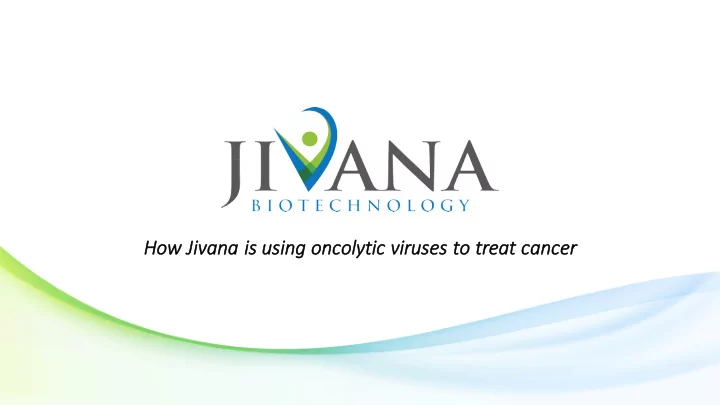

Ho How Ji Jivana is is us using ing onc ncoly lytic ic vi viruses to tre reat canc ancer
Jivana Has Demonstrated a Safe And Effective Gene Therapy Platform • Ji Jivana ta targets ts a specific geneti tic muta tati tion, th the MA MADD Pro rotein, , fo found in a wi wide range of f cancers but unde undetectabl ble in n he healthy hy cells • The Map Kinase Activating Death Domain containing protein prevents cancer cells from undergoing normal apoptotic processes. • Targeting MADD restores normal processes within cancer cells and allows them to undergo apoptosis safely. • MADD has been found in: breast, ovarian, liver, lung, ATC, pancreatic, prostate, and gastic cancers, leukemias, lymphomas, and other cancers. • Ha Has Potential as as a a Sa Safe St Standalone Th Therapy and in Combination Th Therapies • Combination dosing with chemos and inhibitors has demonstrated strong synergies. • Unlocks potential of a new class of DR4/5 agonist and TNF alpha therapeutic treatments. • In Initial Animal Studies es Have e Alrea eady Dem emonstrated ed Tumor Growth In Inhibition of 60% • Breast, liver, and anaplastic thyroid tumors treated with payload only, using siRNA. • Phase 1 clinical trials expected to start second half of 2019. • In In Summary: A New ew Te Technology Paradigm, Disruptive and Complementary to Standards of Ca Care 2
Silencing MADD in Anaplastic Thyroid Tumors Demonstrated Tumor Growth Inhibition (TGI) of 43% Combination dosing with TRAIL Achieved TGI of 60% TGI of 60% provides sufficient rationale to move into the clinic. 3
MADD is Expressed in a WideArray of Cancers –The Challenge is Safe and Effective Delivery of Our Therapeutic Sourced from 1457 cancer cell lines in the Broad Institute's Cancer Cell Line Encyclopedia 4
Jivana is Using Adenoviral Vectors For Safe and Effective MADD Cancer Therapy Adenoviral (Ad) vectors are a type of oncolyticvirus which preferentially infects and kills cancer cells. Replication competent Ad vectors are self amplifying – one virion can replicate inside a cancer cell, create up to 4 million more virions, and then lyse (burst) the cancer cell. The released progeny then seek out and infect additional cancer cells. Other types of oncolyticviruses include the measles virus, vaccina virus, and herpes simplex virus. Adenovirus Capsid 5
Adenovirus Background And Structure Adenoviruses were discovered in 1953, isolated from cultures of human adenoid tissues. They are well characterized, with detailed structural analysis of the Ad virion and extensive functional studies of Ad vector and host cell/tissue interactions having been performed. Ad vectors have been proven safe in over 120 clinical trials. An adenovirus is a large, non-enveloped virus capable of carrying a payload of up to 36Kb and can be used to transport therapeutic genes of interest to tumors. The hexon, penton base, and knobbed fiber are the most important capsid proteins for gene delivery and typically trigger the body’s immune response. 6
Ad Vectors Lyse Cancer Cells And Then Spread Across Paracellular Spaces – Avoiding Neutralising Antibodies 7
Time Course of Infection: Adenoviral Cytopathic Effects on Basal Layers of Cancer Cells 8
Editing The Adenoviral Genome T o Create Chimeric Vectors 9
Chimeric Ad Vectors Can be Designed to be Safer And More Potent Than ‘Wildtype’ Adenoviruses Modifying hexons/fibers/knobs can: 1. Change the tropism of the vector, 2. Reduce liver damage, and, 3. Help escape neutralizing antibodies (NAbs). Fibers of different lengths and flexes can be used to engage receptors over-expressed on cancer cells, and avoid Kupffer cells in the liver. Most patients in North America are seropositive (already have NAbs) for Ad5, the most common and well characterized Ad for cancer therapy, requiring intratumoral injections. Changing the hexon/fiber proteins can avoid NAbs and allow for systemic delivery of Ad vectors. Specific promoters can be used to drive replication of the virus and it’s payload only in cancer cells or in hypoxic environments. (hTERT and CMV). These promoters can also be combined and enhanced. 10
Jivana’s Ad-MADD Vectors Will Amplify The MADD Anti-Cancer Therapy Effect Across a Wide Range of Cancers Ad vector oncolytic action MADD targeted therapy action 11
A safe and effective gene therapy platform for a wide range of cancers delivered with safe and effective oncolytic viral vectors
Contact: Sidney Hopps sid@jivanabiotech.com 917.743.9401
Recommend
More recommend